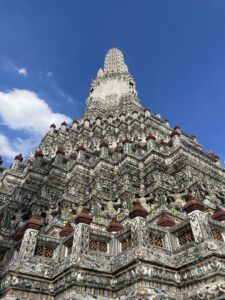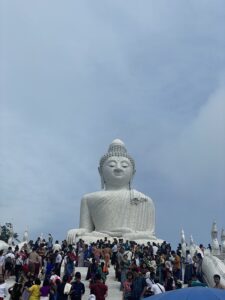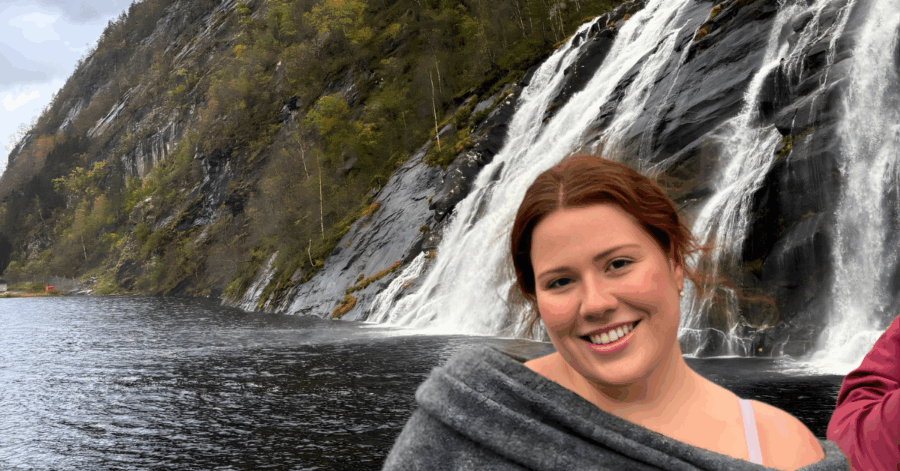
“Sawadeeka. Kopunka. Chai. Mai chai.” These phrases echoed in my mind as my twenty-four-hour flight landed in Bangkok, Thailand. After months of practice, these were the words I committed to memory before embarking on my six-week research opportunity at Chulalongkorn University.
As a first-generation college student, even the thought of getting to and through college wasn’t always an opportunity I saw for my life journey. Since I’ve been at The University of Texas at Austin, the opportunity to travel abroad to Asia has always been a dream of mine and one that fortunately came true.
Combining my love of research and scientific inquiry with this travel opportunity allowed me to immerse myself in a new culture while advancing my academic pursuits. The chance to work on a research project in a vibrant, international setting was incredibly enriching. Seeing how different perspectives and cultural contexts could influence research approaches and outcomes was an inspiring, deeply enriching and transformative experience, demanding a heightened level of adaptability, resilience and cultural sensitivity.
When I initially landed in Bangkok, I learned that the initial research project I intended to work on, the effectiveness of Buddhist walking meditation on cardiovascular and cognitive health, was completed. Although I was disappointed at first, I was able to join another project that aimed at evaluating the effectiveness of swearing in English and Thai on exercise and sports performance. While intriguing and unconventional, this new focus helped me learn the importance of keeping an open mind in the face of uncertainty.
In between taking measurements of Thai speakers doing planks or dipping their hands in 1˚C ice-cold water, I was able to spark rich conversations with participants and connect in various ways. From our love for Despicable Me and the grandiose nature of elephants to learning about different Thai cultural practices, I left every session reminded of the ways in which seemingly small, shared experiences can bridge cultural divides.
Each interaction deepened my appreciation for the uniqueness of Thai culture while highlighting the universal threads that connect us all. By embracing this blend, I learned to navigate the unexpected and found value in the detours of my journey.

When I wasn’t in the lab collecting data or rushing to set up heartbeat monitors, I took the weekends to explore the vast cultural and natural wonders Thailand has to offer. Bangkok, a city pulsating with energy and history, offered an array of experiences allowing me to take a deep dive into Thai culture. From the ornate beauty of the Grand Palace and the serene spirituality of ancient temples to the bustling vibrancy of local markets and street food stalls, Bangkok was a sensory feast.
Each weekend I took the opportunity to explore a different part of Thailand. I wandered through popular weekend markets in Chatuchak, sampled delicious Thai cuisine with intricate flavors and navigated the labyrinthine alleys of bustling districts of Talat Noi and Chinatown. Talat Noi, a historic neighborhood, was so rich in heritage and street art that it gave me a glimpse into the city’s past and its evolving present.

Among the most captivating sites were the temples in Thailand that stood as architectural marvels and spiritual hubs. I had the opportunity to visit Wat Arun, known as the Temple of Dawn, which is famed for its stunning central spire that reflects beautifully in the Chao Phraya River.
Nearby I visited Wat Pho, the Temple of the Reclining Buddha. Was Pho housed one of the largest and most revered Buddha statues in Thailand, showcasing intricate details and a serene atmosphere. A couple of kilometers away, I also visited Wat Samphran, often less crowded and notable for its dragon-themed architecture and unique design, making it a hidden gem in Bangkok’s temple scene.
Venturing beyond Bangkok, Pattaya City showcased a mix of cultural and recreational experiences. I had the opportunity to visit the Sanctuary of Truth, an awe-inspiring wooden structure intricately hand-carved with motifs from Buddhist and Hindu traditions.
There I learned how each panel and statue told a story, merging elements from Buddhist and Hindu teachings to create a profound representation of the interconnectedness of life and spirituality. As I wandered through this majestic edifice, I found myself reflecting on the broader themes of harmony and enlightenment, deepening my appreciation for the cultural tapestry that shapes Thailand.

My next stop was Phuket, a popular island destination, renowned for its picturesque landscapes and cultural landmarks. One of my personal dreams was to visit and admire the beauty of the Phi Phi Islands and Maya Beach. Accessible by boat, their stunning natural beauty was perfect for snorkeling and exploring and vibrant marine life. Back on Phuket, I visited the Big Buddha, a colossal statue overlooking the island, providing both a spiritual experience and panoramic views of the surrounding area.
I was in awe of the sheer scale and tranquility of the Big Buddha. Standing at 45 meters tall, the statue seemed to embody a sense of peace and majesty that permeated the surrounding area. The panoramic views from the site offered a breathtaking perspective of Phuket’s coastline and the shimmering turquoise waters of the Andaman Sea.
My final stop in Thailand was in Chiang Mai, the mountainous region offered thrilling outdoor adventures and immersive cultural experiences. Climbing Doi Inthanon, Thailand’s highest peak, had breathtaking views with diverse flora and fauna. The sounds of the waterfalls and cool snakes and spiders added to the adventure, making the hike both exhilarating and memorable.
The serene atmosphere and the crisp, cool air was a refreshing contrast to the bustling cities I had explored earlier. Later, I visited the Living Green Elephant Sanctuary which offered an ethical way of appreciating Asian elephants. There I got to feed, bath and play with the elephants while learning about conservation efforts made to allow these creatures to live long and healthy lives.

One of my highlights of visiting Chiang Mai was being able to take a Thai cooking class. Here I learned how organic ingredients like turmeric, hot basil and mushrooms were used to make Northern Thai food delicacies. The hands-on experience of chopping herbs, blending spices and tasting each dish as it came together was both educational and enjoyable.
Being able to immerse myself in the culinary traditions of Northern Thailand, I not only learned how to prepare classic dishes like Khao Soi, Pad Thai and Nam Prik Ong, but also gained a deeper appreciation for the intricate balance of flavors that define Thai cuisine. Working with fresh, organic ingredients and mastering traditional cooking techniques, I discovered how integral these elements are to creating authentic and vibrant dishes.
These experiences not only enriched my internship, but also provided a deeper appreciation for Thailand’s unique blend of tradition and modernity. From the bustling markets and serene temples to the pristine beaches and the rich traditions and lush landscapes of Chiang Mai, each adventure added a new dimension to my overall experience in Thailand.
This blend of cultural exploration and scientific discovery deepened my academic pursuits, and broadened my personal horizons, making this experience both professionally rewarding and personally transformative.
I would encourage anyone with even a small of interest in studying or researching abroad to just do it, keep an open mind and embrace the journey with curiosity and flexibility. I am so incredibly grateful to Texas Global and Chulalongkorn University for giving me the opportunity to take the leap, meet incredible people and embark on an adventure that has shaped me in ways I could have never imagined.
This post was contributed by Jessica Jeremiah, a Global Ambassador for Summer 2024. Jessica is a junior public health studies major participating in a faculty-led education abroad program in Bangkok, Thailand.





